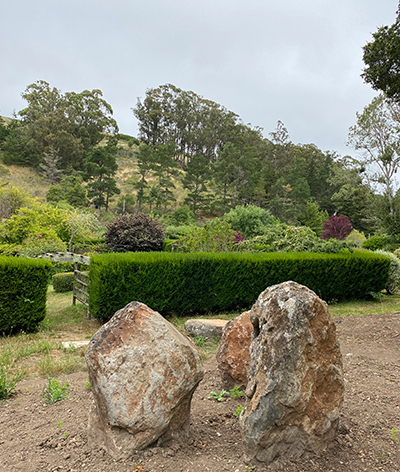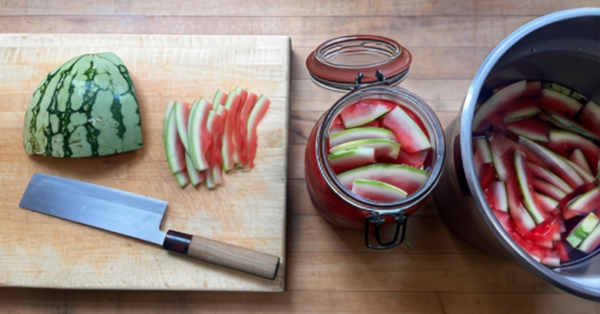
Suzuki Roshi stupa at Green Gulch Farm and Tenshin Reb Anderson, Hoitsu Suzuki, Meiya Wender, and Shungo Suzuki. Photo at left by Tova Green; photo at right by Sara Tashker.
By Tova Green, with Eijun Linda Cutts, Meiya Wender, Sara Tashker, and Thiemo Blank
Work is underway at Green Gulch Farm to create a peaceful, easily accessible memorial site where Zen students and the wider sangha can remember their teachers and Dharma friends. The Suzuki Roshi stupa, which stood on the hillside above the Green Gulch garden for many years, has recently been enshrined there.
The new Suzuki Roshi Memorial Garden is lovely and quiet, tucked into the foot of a hill behind the Herb Circle in the Green Gulch garden. It is visible from the turnoff to Highway 1 and from the gate as you enter the garden, signaling its connection to and importance within the temple grounds.
Mark Bourne, of Windsmith Design, who has been working on landscaping projects at Green Gulch Farm for over fifteen years, is leading the memorial garden’s design and construction. Tea teacher Meiya Wender met Mark when she was looking for someone to design the roji (garden connected to the tea house). Mark has worked closely with Meiya, Green Gulch Director Thiemo Blank, and Senior Dharma Teachers Furyu Schroeder and Eijun Linda Cutts to envision and develop the site.
Linda Cutts noted that early in the process of creating the memorial garden, when Mark met with the Green Gulch team, he could envision the site and see the possibilities of the space in a fresh way. “He could see that the area behind the herb circle would work well by removing a few trees and shaping the earth.”

Memorial site. Photo by Tova Green.
Having moved Suzuki Roshi’s stupa to the memorial site, Mark is now working on an area where the memorial markers for SFZC’s abbots will be placed. Next, work will begin on the area with markers for those who have been shuso (head student), both priest and lay.
Meiya has been thinking about what will be used for markers—the equivalent of gravestones in cemeteries. On a recent trip to Japan, Meiya visited cemeteries to see the traditional stone markers that are used there.
She also consulted with a Japanese priest, Taimei Ohara, who is knowledgeable about the design of Japanese cemeteries. Meiya sent him photos of the Green Gulch site and a photo she had taken of the grave markers at Rinso-in. Tamei-san said that the marker type used for abbots is called 卵塔 rantō, literally “egg (shape) pagoda.” Smaller ones of the same shape are sometimes used for other priests. Rantō will be used for abbots and priests who were shuso and another style will be used for lay shusos.
When Meiya visited Suzuki Roshi’s home temple Rinso-In last fall, she told his son, Hoitsu Suzuki Roshi, about the plans for the memorial site. Hoitsu gave her a Hanko (seal) that belonged to his father to put in the stupa since he didn’t have his father’s ashes. It is common in many Buddhist traditions to place a relic in a memorial when ashes are unavailable.
The Suzuki Roshi Memorial Site promises to be a welcoming, peaceful place of pilgrimage for Zen students and visitors to honor the lives and deaths of our lineage’s teachers.
If you are interested in supporting this project and its ongoing maintenance, please consider donating to the Suzuki Roshi Memorial Garden Fund.











